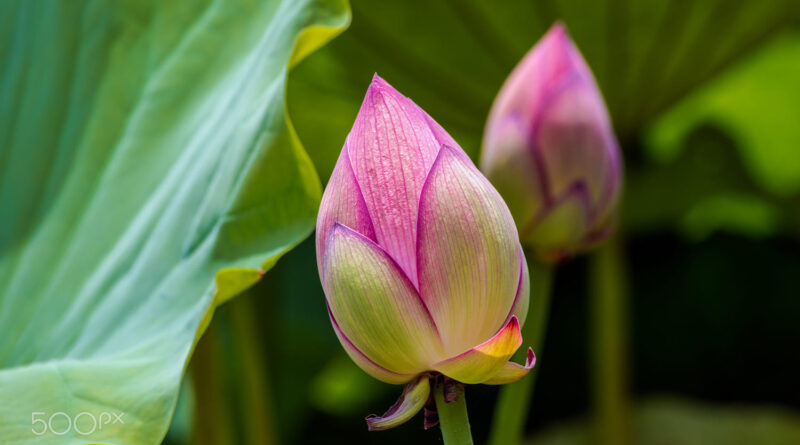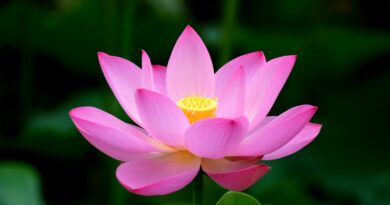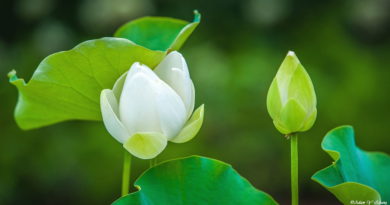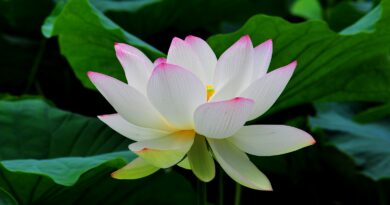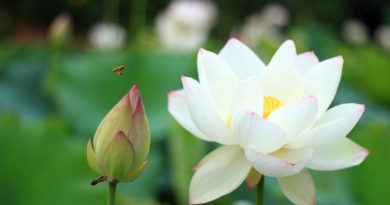ABHIDHAMMA IN DAILY LIFE – CHAPTER 21: SAMATHA
ABHIDHAMMA IN DAILY LIFE – CHAPTER 21: SAMATHA
We would like to have more wholesomeness in our life, but often we are unable to do wholesome deeds, to speak in a wholesome way or to think wholesome thoughts. Our accumulated defilements hinder us in the performing of kusala. We learn from the Buddhist teachings that there are ‘hindrances’ (nivarana), which are akusala cetasikas, arising with akusala cittas. We all have these hindrances. They are:
– sensuous desire, in Pali: kamacchandha
– ill-will, in Pali: vyapada
– torpor and languor, in Pali: thina and middha
– restlessness and worry, in Pali: uddhacca and kukkucca
– doubt, in Pali: vicikiccha
Kamacchandha or sensuous desire is the cetasika which is lobha (attachment). It is attachment to the objects we can experience through the sense-doors and the mind-door. We all have kamacchandha in different forms and intensities. Because of economic progress and technical inventions there is more prosperity in life. One can afford more things which make life pleasant and comfortable. This, however, does not bring contentedness; on the contrary, we are not satisfied with what we have and we are forever looking for more enjoyment and happiness. There is kamacchandha with our deeds, words and thoughts. Even when we think that we are doing good deeds and helping others, kamacchandha can arise. Kamacchandha makes us restless and unhappy.
Vyapada or ill-will is the cetasika which is dosa. Vyapada can trouble us many times a day; we feel irritated about other people or about things which happen in life. Vyapada prevents us from kusala. When there is vyapada we cannot have lovingkindness and compassion for other people.
Thina and middha are translated as ‘torpor’ and ‘languor’, or as ‘sloth’ and ‘torpor’. Thina and middha cause us to have lack of energy for kusala. The ‘Visuddhimagga’ (XIV, 167) states concerning thina and middha :
… Herein, stiffness (thina) has the characteristic of lack of driving power. Its function is to remove energy. It is manifested as subsiding. Torpor (middha) has the characteristic of unwieldiness. Its function is to smother. It is manifested as laziness, or it is manifested as nodding and sleep. The proximate cause of both is unwise attention to boredom, sloth, and so on.
Don’t we all have moments in a day when there is laziness and lack of energy to perform kusala? When, for example, we are listening to the preaching of Dhamma or reading the scriptures, there are opportunities for kusala cittas. Instead, we may feel bored and we lack the energy for kusala. It may happen that we see someone else who needs our help, but we are lazy and do not move. Then we are hindered by thina and middha. Thina and middha make the mind unwieldy (Vis XIV 105, where the hindrances are mentioned as being specifically obstructive to jhana.).
Uddhacca is translated as ‘agitation’ or ‘excitement’ and kukkucca as ‘worry’ or ‘flurry’. Uddhacca arises with each and every type of akusala citta. It prevents the citta from wholesomeness.
As regards kukkucca, worry, the ‘Visuddhimagga’ (XIV, 174) states:
…It has subsequent regret as its characteristic. Its function is to sorrow about what has and what has not been done, It is manifested as remorse. Its proximate cause is what has and what has not been done. It should be regarded as slavery.
When we have done something wrong or we have not done the good deed we should have done, we might be inclined to think about it again and again. We may ask ourselves why we acted in the way we did, but we cannot change what is past already. While we worry we have akusala cittas; worry makes us enslaved. Uddhacca and kukkucca prevent us from being tranquil.
As regards vicikiccha, doubt, there are many kinds of doubt. One may have doubts about the Buddha, the Dhamma and the Sangha, or doubt about the Eightfold Path. Doubt is akusala and a hindrance to the performing of Kusala.
All of the hindrances are obstructions to the performing of kusala. Is there a way to eliminate them? Samatha or the development of calm is a way to temporarily eliminate the hindrances. The calm which is developed in samatha has to be wholesome calm, it cannot arise with akusala citta. There is a degree of calm with each kusala citta but it is hard to know the characteristic of calm precisely, because there are bound to be akusala cittas very shortly after the kusala cittas. In order to develop the calm which is temporary freedom from the hindrances, right understanding (panna) is indispensable. If one merely tries to concentrate on a meditation subject without right understanding of kusala and akusala and of the characteristic of calm, calm cannot grow. The panna of samatha does not eradicate defilements, but it knows the characteristic of calm and it knows how it can be developed by means of a suitable meditation subject. Akusala citta is likely to arise time and again, also when one applies oneself to samatha. One may be attached to silence and then there is akusala citta instead of the calm of samatha. Or one may think that when there is no pleasant feeling nor unpleasant feeling but indifferent feeling there is calm. However, indifferent feeling can arise with kusala citta as well as with akusala citta; lobha-mula-citta can be accompanied by indifferent feeling and moha-mula-citta is invariably accompanied by indifferent feeling. Thus, when there is indifferent feeling it may seem that one is calm, but there is not necessarily the wholesome calm of samatha. The panna of samatha must be very keen in order to recognize the defilements which arise, even when they are more subtle.
We read in the scriptures about people who could attain jhana if they cultivated the right conditions for it. Before the Buddha’s enlightenment jhana was the highest form of kusala people could attain. Jhana, which is sometimes translated as absorption, is a high degree of calm. At the moment of jhanacitta one is free from sense-impressions and from the defilements which are bound up with them. The attainment of jhana is extremely difficult, not everybody who develops samatha can attain it. However, even if one has no intention to cultivate jhana there can be conditions for moments of calm in daily life if there is right understanding of the characteristic of calm and of the way to develop it.
In the cultivation of samatha one develops five cetasikas which can eliminate the hindrances; they are the jhana-factors.
The first jhana-factor is vitakka, which is translated into English as ‘applied thinking’. Vitakka is a mental factor (cetasika) which arises with many kinds of citta ; it can arise with kusala citta as well as with akusala citta. When the wholesome kind of vitakka is developed in samatha it is one of the jhana-factors.
The ‘Visuddhimagga’ (lV, 88) states concerning vitakka:
… Herein, applied thinking (vitakkana) is applied thought (vitakka); hitting upon, is what is meant. It has the characteristic of directing the mind onto an object (mounting the mind on its object). Its function is to touch and strike– for the meditator is said, in virtue of it, to have the object touched at by applied thought, struck by applied thought. It is manifested as the leading of the mind onto an object…
Vitakka, when it is a jhana-factor, is opposed to thina and middha (sloth and torpor). In ‘thinking’ of the meditation-subject vitakka helps to inhibit thina and middha temporarily.
Another jhana-factor is vicara, which is translated as ‘sustained thinking’. This cetasika arises with different kinds of citta, but when it is developed in samatha, it is a jhana-factor. The ‘Visuddhimagga’ (IV, 88) states concerning vicara:
… Sustained thinking (vicarana) is sustained thought (vicara); continued sustainment (anusancarana), is what is meant. It has the characteristic of continued pressure on (occupation with) the object. Its function is to keep conascent (mental) states (occupied) with that. It is manifested as keeping consciousness anchored (on that object).
In samatha, vicara keeps the citta anchored on the meditation subject. When we continue to think of wholesome subjects such as the Buddha’s virtues or his teachings there is no vicikiccha or doubt. Vicara helps to inhibit doubt.
Another jhana-factor is piti, translated as ‘rapture’, ‘enthusiasm’ or ‘happiness’. Piti arises also with akusala cittas, but when it is developed in samatha it is a jhana-factor. The ‘Visuddhimagga’ (IV, 94) states concerning piti:
…It refreshes (pinayati), thus it is happiness (piti). It has the characteristic of endearing (sampiyayana). Its function is to refresh the body and the mind; or its function is to pervade (thrill with rapture). It is manifested as elation. But it is of five kinds as minor happiness, momentary happiness, showering happiness, uplifting happiness, and pervading (rapturous) happiness.
According to the ‘Visuddhimagga’ (IV, 99) the jhana-factor piti is the ‘pervading happiness’ which is the root of absorption and comes by growth into association with absorption.
When piti is developed in samatha it inhibits the hindrance which is ill-will (vyapada). However, keen understanding is needed in order to know whether there is akusala piti which arises with attachment or kusala piti. Even when one thinks that there is wholesome enthusiasm about a meditation subject, there may be clinging. The jhana-factor piti takes an interest in the meditation subject without clinging. Wholesome piti which delights in the Buddha, the Dhamma and the Sangha or in another meditation subject refreshes the mind and then there is no aversion, no boredom as to kusala.
Another jhana-factor is sukha. This jhana-factor is not bodily pleasant feeling (sukha vedana), but it is somanassa or mental happy feeling. Sukha which is developed in samatha is happy feeling about a meditation subject. However, as we know, happy feeling arises also with attachment. Panna should know precisely when happy feeling is akusala and when it is kusala. The jhana-factor which is wholesome sukha inhibits the hindrances which are restlessness and worry (uddhacca and kukkucca). When there is wholesome happy feeling about a meditation subject there is no restlessness and no worry.
Piti and sukha are not the same. Sukha, which is translated as happiness, bliss, ease or joy, is happy feeling. Piti, which is translated as joy, rapture, zest, and sometimes also as happiness, is not feeling; it is not vedanakkhandha, but sankharakkhandha (the khandha which is all the cetasikas, except vedana and sanna). When reading the English translations, we have to find out from the context which cetasika is referred to, piti or sukha.
The ‘Visuddhimagga’ (IV, 100) states concerning the difference between happiness (piti) and bliss (sukha):
And wherever the two are associated, happiness (piti) is the contentedness at getting a desirable object, and bliss (sukha) is the actual experiencing of it when got. Where there is happiness there is bliss (pleasure); but where there is bliss there is not necessarily happiness. Happiness is included in the sankharakkhandha; bliss is included in the vedanakkhandha (feeling). If a man exhausted in a desert saw or heard about a pond on the edge of a wood, he would have happiness; if he went into the wood’s shade and used the water, he would have bliss…
The jhana-factor which is samadhi or concentration is the cetasika which is ekaggata cetasika. This cetasika arises with every citta and its function is to focus on an object. Each citta can have only one object and ekaggata cetasika focuses on that one object. Ekaggata cetasika or samadhi can: be kusala as well as akusala. Samadhi when it is developed. in samatha is wholesome concentration on a meditation subject.) Together with samadhi there must be right understanding which knows precisely when the citta is kusala citta and when akusala citta and which knows how to develop calm, otherwise the right concentration of samatha will not grow. If one tries very hard to concentrate without there being right understanding there may be attachment to one’s effort to become concentrated, or, if one cannot become concentrated, aversion may arise. Then calm cannot grow. If there is right understanding there are conditions for samadhi to develop. The ‘Visuddhimagga’ (XIV, 139) states concerning samadhi:
It puts (adhiyati) consciousness evenly (samam) on the object, or it puts it rightly (samma) on it, or it is just the mere collecting (samadhana) of the mind, thus it is concentration (samadhi). Its characteristic is non-wandering, or its characteristic is non-distraction. Its function is to conglomerate conascent states as water does bath powder. It is manifested as peace. Usually its proximate cause is bliss. It should be regarded as steadiness of the mind, like the steadiness of a lamp’s flame when there is no draught.
Samadhi inhibits kamacchandha (sensuous desire). When there is right concentration on a subject of meditation, one is at that moment not hindered by kamacchandha.
Summarizing the five jhana-factors, necessary for the attainment of the first stage of jhana, they are:
– vitakka,which is translated as applied thinking.
– vicara,which is translated as sustained thinking.
– piti,which is translated as enthusiasm, rapture or happiness.
– sukha,which is translated as happy feeling or bliss.
– samadhi, which is concentration.
The jhana-factors have to be developed in order to temporarily eliminate the hindrances. For the person who wants to develop the jhana-factors and attain jhana a great deal of preparation is required. We read in the ‘Visuddhimagga’ (II, 1; III, 1) that the person who wants to cultivate samatha should be well established in sila (morality), which is purified by such qualities as fewness of wishes, contentment, effacement, seclusion, energy, and, modest needs. In observing some of the ascetic practices (as described in Ch. II of the ‘Visuddhimagga’), which pertain mostly to the monk with regard to the use of his robes, his almsfood and his place of dwelling, virtue will become more perfected.
In the Buddha’s time laypeople too could attain jhana, if they would lead a life which was compatible with its development (An example is Nanda’s mother, about whom we read in the ‘Gradual Sayings’, Book of the Sevens, Ch. V, par, 10.), One should lead a secluded life and many conditions have to be fulfilled. Jhana is quite incompatible with sense-desires. One has to be ‘quite secluded from sense-desires…’ in order to attain the first jhana, as we read in many suttas.
The ‘Visuddhimagga’ (IV, 81) explains:
When absoluteness is introduced thus ‘quite secluded from sense desires’, what is expressed is this: sense desires are certainly incompatible with this jhana: when they exist, it does not occur, just as when there is darkness, there is no lamplight; and it is only by letting go of them that it is reached just as the further bank is reached by letting go of the near bank. That is why absoluteness is introduced.
Thus we see that the development of jhana is not for everyone. Jhana cannot be attained if one leads a ‘worldly life’, full of sense-pleasures, instead of a life of ‘fewness of wishes, seclusion, modest needs’.
The ‘Visuddhimagga’ (III, 129) also states that one should sever any impediments to the development of samatha. Among them are one’s dwelling, travelling and sickness. These can be hindrances to samatha. One should avoid living in a monastery which, for various reasons, is unfavourable to the development of samatha. Thus, even before one starts to develop samatha, many conditions have to be fulfilled.
For the development of samatha one has to apply oneself to a suitable subject of meditation. There are forty meditation subjects which can condition calm and they are the following:
10 kasina exercises, which are, for example, coloured disks, a piece of earth, light.
10 loathsome subjects (in Pali: asubha), the ‘cemetery meditations’.
10 recollections, comprising the recollection of the Buddha, the Dhamma, the Sangha, virtue, generosity, deities, and also the recollections which are: mindfulness of death, mindfulness of the body, mindfulness of breathing and the recollection of peace (nibbana).
The perception of repulsiveness in nutriment.
The definition of the four elements (earth, water, fire and wind).
4 brahma-viharas (divine abidings) comprising: lovingkindness (metta), compassion (karuna), altruistic joy (mudita) and equanimity (upekkha) which, in this case, is not upekkha vedans or neutral feeling, but the wholesome cetasika which is tatramajjhattata.
4 meditation subjects for the development of the arupa-jhanas (immaterial jhanas), which will be mentioned later on.
Not all subjects are suitable for everybody, it depends on the individual which subject is a means for him to become calm. If there is right understanding of the way to become calm by means of a suitable meditation subject calm can grow, even in our daily life. Metta and karuna, for instance, can and should be developed in our daily life, when we are in the company of other people and then there are kusala cittas instead of akusala cittas. Recollection on the Dhamma includes also reflection on the teachings and this is beneficial for everybody; it helps one to begin to understand one’s life. While we reflect with kusala citta on the teachings or on one of the other meditation subjects, there are moments of calm if we do not cling to calm.
In the ‘Visuddhimagga’ it is explained how one can develop higher degrees of calm by means of a meditation subject. It is explained (Vis. III, 119) that meditation subjects are learned by sight, by touch and by hearsay (words), depending on the nature of the subject. As regards the subjects which are learned by sight (such as nine of the kesinas and the ‘ten cemetery-meditations’), the ‘Visuddhimagga’ (IV, 31) states that in the beginning one has to look closely at the meditation subject and later on one acquires a ‘mental image’ (‘sign’, in Pali: nimitta) of it; one no longer needs to look at the original object. At first the mental image is still unsteady and unclear, but later on it appears ‘a hundred times, a thousand times more purified…’ The original object, for example a coloured disk or a piece of earth, could have flaws, but the perfected mental image which one acquires when one is more advanced, does not have the imperfections of the original object one was looking at in the beginning. This perfected mental image is called the ‘counterpart sign’ (patibhaga nimitta).
At the moment the ‘counterpart sign’ arises, there is a higher degree of calm and concentration is more developed. This stage is called ‘access concentration’ (upacara samadhi). The citta is not jhanacitta, it is still kamavacara citta (of the sense-sphere), but the hindrances do not arise at the moment of ‘access concentration’. However, the jhana-factors are not developed enough yet for the attainment of jhana and now one has to cultivate the right conditions in order to attain jhana. ‘Access concentration’ is already very difficult to attain, but ‘guarding the sign’ which has to be done in order to attain jhana is also very difficult. One has to ‘guard the sign’ (nimitta) in order not to lose the perfected mental image one has developed. The conditions for guarding the sign are, among others, the right dwelling-place, suitable food, avoidance of aimless talk. One should ‘ balance’ the ‘five faculties’ (indriyas) which are the following cetasikas:
– saddha (confidence in wholesomeness)
– viriya (energy)
– sati (mindfulness)
– samadhi (concentration)
– panna (wisdom)
Confidence should be balanced with wisdom so that one has not confidence uncritically and groundlessly. Concentration should be balanced with energy, because if there is too much energy and not enough concentration, there is a danger of becoming agitated and then one cannot attain jhana. If there is concentration but not enough energy there will be idleness and jhana cannot be attained either. All five indriyas should be balanced.
From the foregoing examples we see that samatha cannot be cultivated without a basic understanding of the realities taught in the Abhidhamma which are in fact the realities of daily life, and without careful consideration of them. One should know precisely when the citta is kusala citta and when it is akusala citta. One should know which realities the jhana-factors are and one should realize as regards oneself whether the jhana-factors are developed or not. One should know whether the cetasikas which are the five indriyas (faculties) are developed or not, whether they are balanced or not. If there is not the right understanding of all these different factors and conditions necessary for the attainment of ‘access concentration’ and of jhana, one is in danger of taking for ‘access concentration’ what is not ‘access concentration’ and taking for jhana what is not jhana. Neither ‘access concentration’ nor jhana can be attained without having cultivated the right conditions.
Not all meditation subjects lead to jhana, some have only ‘access concentration’ as their result, such as the recollections of the Buddha, the Dhamma and the Sangha. Some meditation subjects lead only to the first stage of rupa-jhana {Both rupa-jhana (material jhana) and arupa-jhana (immaterial where the meditation subject is no longer dependent on materiality) developed in different stages of jhana. When one is more advanced, can attain a higher stage of jhana. Arupa-jhana is more refined than rupa-jhana }, some to all stages of rupa-jhana. The meditation subject which is ‘mindfulness of breathing’ can lead to all stages of rupa-jhana. This meditation subject which is considered by many to be relatively easy, is one of the most difficult. One has to be mindful of one’s in-breath and out-breath where they touch the tip of the nose or the upper-lip. This meditation subject is not learnt by sight, but by touch : the in-breath and the out-breath are the ‘sign’ (nimitta) one has to continue one’s attention to. We read in the ‘Visuddhimagga’ (VIII, 208):
For while other meditation subjects become clearer at each higher stage, this one does not: in fact, as he goes on developing it, it becomes more subtle for him at each higher stage, and it even comes to the point at which it is no longer manifest.
Further on (Vlll, 210, 211) we read:
… This was why the Blessed One said: ‘Bhikkhus, I do not say of one who is forgetful, who is not fully aware, (that he practises) development of mindfulness of breathing.’ (Middle Length Sayings III, No. 118, 84)
Although any meditation subject, no matter what, is successful only in one who is mindful and fully aware, yet any meditation subject other than this one gets more evident as he goes on giving it his attention. But this mindfulness of breathing is difficult, difficult to develop, a field in which only the minds of Buddhas, Pacceka Buddhas, and Buddhas’ sons are at home. It is no trivial matter, nor can it be cultivated by trivial persons. In proportion as continued attention is given to it becomes more peaceful and more subtle. So strong mindfulness and understanding are necessary here.
Mindfulness of breathing is very difficult, ‘it is no trivial matter’. When one continues to be mindful of breathing, the in-breaths and out-breaths become more and more subtle and thus harder to notice. We just read in the quotation that strong mindfulness and understanding are necessary here. Not only in vipassana, but also in samatha, mindfulness (sati) and understanding (panna are necessary but the object of awareness in samatha is different from the object of awareness in vipassana. In samatha the object of awareness is the meditation subject and the aim is to develop calm. In vipassana the object of awareness is any nama or rupa which appears at the present moment through one of the six doors, in order to eradicate the wrong view of self and eventually all defilements. Through samatha the latent tendencies of defilements are not eradicated ; when there are conditions akusala cittas arise again. We read in the ‘Gradual Sayings’ (Book of the Sixes, Ch. VI, par. 6, Citta Hatthisariputta) that even the monk who can attain jhana, may ‘disavow the training’ and return to the layman’s life. We read that when the Buddha stayed near Varanasi in the Deer Park at Isipatana, a number of ‘elders’ had a talk on Abhidhamma. Citta Hatthisariputta interrupted their talk from time to time. Maha Kotthita said to him:
‘Let not the venerable Citta Hatthisariputta constantly interrupt the elders’ Abhidhamma talk ; the venerable Citta should wait until the talk is over!’
And when he had thus spoken, Citta’s friends said : ‘The venerable Maha Kotthita should not censure the venerable Citta Hatthisariputta. A wise man is the venerable Citta and able to talk to the elders on Abhidhamma.’
‘It is a hard thing, sirs, for those who know not another person’s ways of thought. Consider, sirs, a person who, so long as he lives near the Master or a fellow-teacher in the brahman life, is the most humble of the humble, the meekest of the meek, the quietest of the quiet ; and who, when he leaves the Master or his fellow-teachers, keeps company with monks, nuns, lay-disciples, men and women, rajahs, their ministers, course-setters or their disciples. Living in company, untrammeled, rude, given over to gossip, passion corrupts his heart ; and with his heart corrupted by passion, he disavows the baining and returns to the lower life. . .
Consider again a person who, aloof from sensuous appetites… enters and abides in the first jhana. Thinking: ‘I have won to the first jhana’, he keeps company …living in company, untrammeled, rude, given over to gossip, passion corrupts his heart ; and with his heart corrupted by passion, he disavows the training and returns to the lower life…’
The same is said about the other stages of jhana. We then read that Citta Hatthisariputta disavowed the training and returned to the lower life. But not long after that he ‘went forth’ (became a monk) again. We read:
And the venerable Citta Hatthisariputta, living alone, secluded, earnest, ardent, resolved, not long after, entered and abode in that aim above all of the brahman life–realizing it here and now by his own knowledge–for the sake of which clansmen rightly go forth from home to the homeless life: and he knew: ‘Birth is destroyed, the brahman life is lived, done is what was to be done, there is no more of this.’
And the venerable Citta Hatthisariputta was numbered among the arahats.
Even if one can attain the highest stage of jhana, one’s heart can still become ‘corrupted by passion’, as we read in the sutta. When Citta Hatthisariputta had attained arahatship, he had realized the ‘aim above all of the brahman life’. The hindrances could not arise any more.
Through vipassana, hindrances are eradicated in the successive stages of enlightenment. The sotapanna (who has attained the first stage of enlightenment) has eradicated the hindrance which is doubt (vicikiccha); the anagami (who has attained the third stage of enlightenment) has eradicated the sensuous desire (kamacchandha), ill-will (vyapada) and worry (kukkucca); the arahat has eradicated sloth and torpor (thina and middha) and restlessness (uddhacca), he has eradicated all defilements.
-ooOoo-
Questions
- Which paramattha dhamma are the jhana-factors?
2. Which khandha is the jhana-factor which is piti (rapture)?
3. Which khandha is the jhana-factor which is sukha (pleasant feeling)?
4. When seeing now, is there ekaggata cetasika? What is its function?
5. What is the function of ekaggata cetasika which arises with the jhanacitta? What is its object?
6. What is the function of ekaggata cetasika arising with the panna (wisdom) of the Eightfold Path which realizes a characteristic of nama or rupa? What is its object at that moment?
7. Why is mindfulness of breathing one of the most difficult subjects of meditation?
8. What is the difference between samma-sati (right mindfulness) in samatha and samma-sati in vipassana? What are their respective objects of awareness?
9. If one only develops samatha and not vipassana, why can the hindrances not be eradicated?

